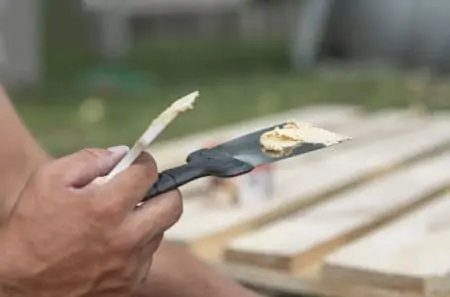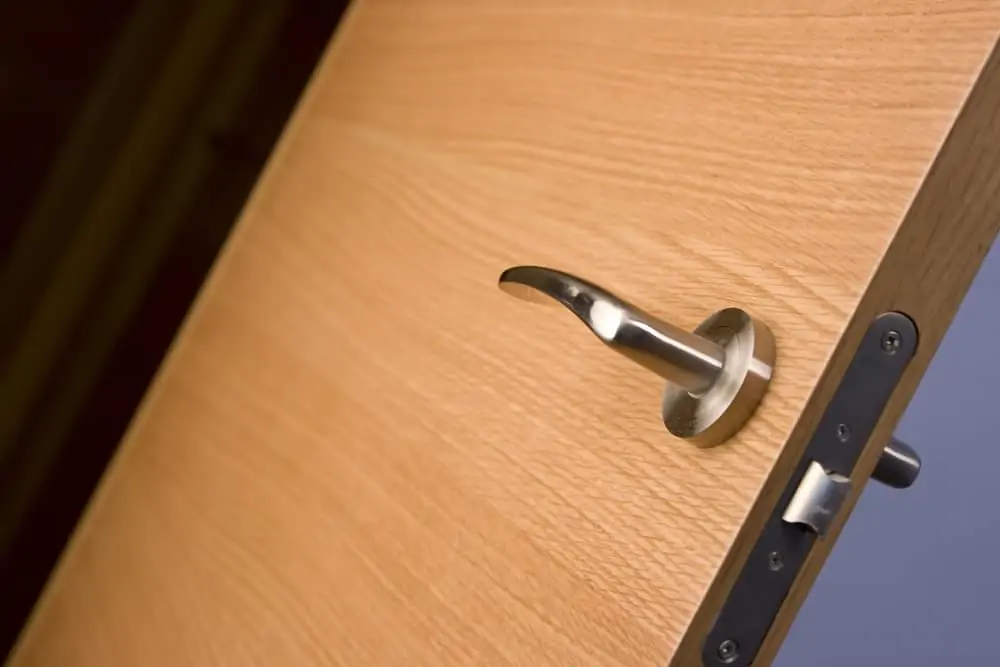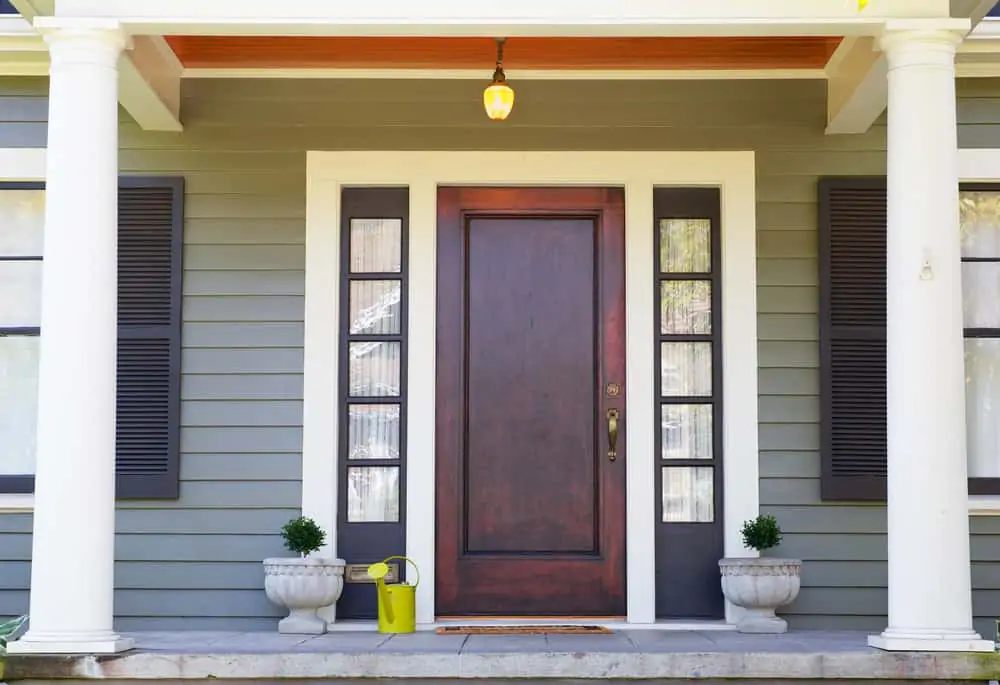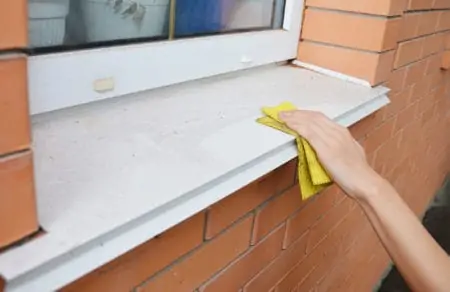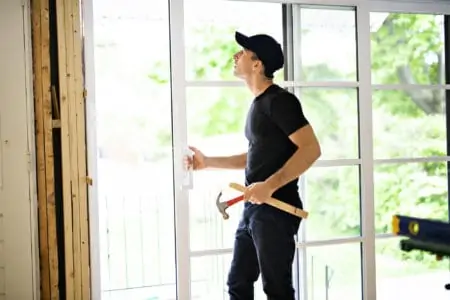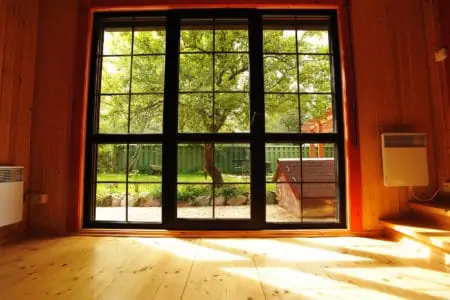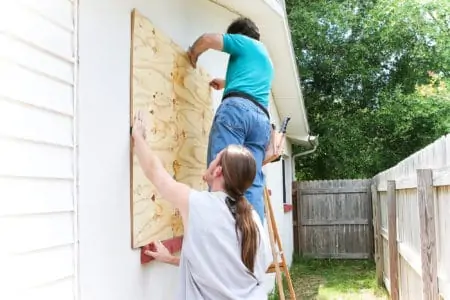Fixing a hole in a door is a simple process that luckily most DIY enthusiasts can handle. So before you rush out to buy a new door, consider repairing the door and saving some money.
We show you how to fix a hole in a door, talk about the cost of replacing the door, and offer ideas for temporary fixes.
Key Takeaways
- Understand door types: Hollow-core doors are lightweight and inexpensive, while solid-core doors are heavy, secure, and more expensive.
- Repair hollow doors: Clean hole edges, insert cardboard, fill with expanding foam, and apply wood filler before painting.
- Repair solid doors: Clean crack edges, insert glue-soaked string, apply wood filler, and paint the repaired area.
- Consider cost and appearance: Weigh the cost of repairing vs. replacing the door and ensure a seamless appearance after repair.
Hollow-Core Doors Vs. Solid-Core Doors
Most doors fall into two categories: hollow-core and solid-core. But what is the difference, and which is best? To answer these questions, you need to understand what these terms mean.
Hollow-Core
Hollow-core doors have soared in popularity over the last couple of decades. They are excellent choices for interior rooms, but you wouldn’t use one as an exterior door as they lack the structural integrity of solid-core doors.
While they are not actually hollow, they consist of two thin panels sandwiching honeycomb or wood-block filling. The core gives the doors their rigidity while retaining a lightweight feel. The difference in weight is the easiest way to tell the two types of doors apart.
Hollow-core doors are cheaper than solid-core models, making them a firm favorite for designers, builders, and homeowners.
Pros
- Lightweight.
- Inexpensive.
- Easy to install.
- Ideal for interior rooms.
Cons
- Lacks strength.
- Not suitable as exterior doors.
Solid-Core
Solid-core doors have a solid core (you knew that, right?). They are made from solid wood but sometimes consist of several pieces (typically panels held between a door frame).
Solid-core wooden doors have been the standard for exterior doors in North America for generations because they offer many benefits. They are rigid, hard to punch through, and add a level of security that hollow doors cannot.
This makes them the ideal choice for exterior doors. Plus, solid wood withstands everything the weather can hurl at it.
You can tell if your door is solid by tapping it. Hollow doors sound hollow (go figure!), while solid doors (you guessed it) sound solid.
Solid-core doors are also expensive for all the reasons mentioned above. Expect to pay several times the price compared to a hollow-core door.
Pros
- Heavyweight.
- Adds security.
- Ideal for exterior doors.
- Stands up to the elements.
Cons
- Expensive.
- Heavy.
- More challenging to install.
How to Repair Holes in Hollow Doors
The time has come to finally fix that hole you made putting your shoe through the hollow door. It’s only taken you two years to sort. Knowing how to repair a hole in a door is a useful skill, but you will need the right tools and materials before starting.
What You’ll Need
- Hammer.
- Utility knife.
- Screwdriver.
- Needle-nose pliers.
- Putty knife.
- Popsicle stick.
- Sandpaper (220-grit).
- Paintbrush.
- Cardboard.
- Expanding foam.
- Plastic wood.
- Masking tape.
- Paint.
- Two sawhorses.
- Use your screwdriver and hammer to tap the hinge pin out of the housing to release the door. Failing that, remove the screws that hold the hinge to the frame. Remove the door and lay it flat on a set of sawhorses.
- Remove any rough material from around the hole using the utility knife. You are aiming for a smooth edge. If you can slightly bevel the edges of the hole, it gives the patching material more surface to bond with.
- Use the needle-nose pliers to remove larger pieces of wood.
- Cut a cardboard strip slightly narrower than the depth of the door. It should be long enough to go around the circumference of the hole.
- Push the cardboard strip into the hole (between the inner and outer panels) to form a barrier for the expanding foam.
- Once the cardboard is set in place, add the expanding foam. Try not to add too much because it could crack your door as it expands.
- Coat the hole’s edge in masking tape to prevent the foam from adhering to the door’s surface.
- Wait for the foam to set. This will take about four hours.
- Use the utility knife to cut away any excess foam that has expanded out of the hole.
- Now remove the masking tape and open the wood filler. Apply it to the affected area and smooth it with the popsicle stick. Make sure it fills all the gaps without air bubbles.
- Wait several hours while the plastic wood filler dries.
- Grab the fine-grit sandpaper and smooth the filler so that it is flush with the surface of the door.
- Wipe the sawdust away and clean the surface of the door with a damp cloth.
- Load your paintbrush with your chosen paint and cover the door. Two coats should be enough.
- Once the paint dries, rehang the door using the reverse procedure of removing the door.
Top Tip
To reinforce the door against future damage, install wall guards like this pack of four door-stoppers. You could also drill holes every 12 inches around the edge of the door and fill them with insulating foam.
How to Repair Holes in Solid Doors
Solid wooden doors are more likely to suffer from cracks rather than holes. It happens when the wood comes into contact with fluctuating temperatures. The wood expands and retracts and then cracks.
If left, these cracks can become significant, making your door leaky. As before, you need to gather the right tools and materials before you get started. So, what’s in your repair kit?
What You’ll Need
- Utility knife.
- Hacksaw blade.
- Flathead screwdriver.
- Putty knife.
- Paper towels.
- Paintbrush.
- Sandpaper (220-grit).
- Natural fiber string.
- PVA glue.
- Plastic wood filler.
- Paint.
- Clean the edges of the crack using the utility knife. Remove any debris that has accumulated in the gap with the hacksaw blade.
- Measure two lengths of string slightly longer than the crack to give you something to grip.
- Soak one piece of string in the PVA glue. If the glue is too thick, consider watering it down to help it fully absorb.
- Poke the string into the crack using the flathead screwdriver. Repeat this process with the second length of string, taking care not to push it out the other side of the door.
- Let the glue harden before proceeding to the next step. This may take several hours.
- Wipe the surface with a paper towel to ensure the surface is clean.
- Apply the wood filler and smooth it with the putty knife. Wait several hours while the filler dries.
- Sand the filler with the fine-grit sandpaper until it is smooth with the door’s surface.
- Wipe the area clean with a damp paper towel, and now you are ready for painting.
Grab the paintbrush and load it with your chosen paint. Two coats should be enough to protect the door. If you can get a color that matches the door, you will only need to paint the area around the repair rather than the entire door.
Should You Repair or Replace the Door?
Knowing how to patch a hole in a door is one thing, but when should you replace it rather than repair it? If the hole or crack compromises the door’s structural integrity, it may be better to replace it. That said, wooden doors are expensive compared to hollow-core doors.
Hollow-core doors are cheap to buy, so if you don’t have the time to make the repair, getting a new one might be your best option. Front and back doors have to cope with the pressures of the weather, meaning they need higher maintenance levels.
If you leave cracks unattended, they expand and become possible weak spots. Over time, your door leaks air and water, increasing your heating costs.
A lot comes down to the size of the hole or crack. Repairing is not the same as patching the hole. You may as well replace the door if you can still see where the gap used to be.
Also, can you get a new door that exactly matches all the others inside your home? If the answer is no, attempt the repair because the rest will need to be changed once you change one door.
Cost to Fix a Hole In a Door
Getting a professional to fix the hole in your door will likely cost you more than the door itself. If that’s the case, you may as well replace the door. The average price for a pro repair ranges from $120 to $330.
You will only pay for the supplies and materials for a DIY repair, which will likely be no more than $50. However, if the new door costs you $60, you may as well save yourself the bother and get a new door.
Cost to Replace a Door
You can pick up a second-hand hollow-core door for around $10. If you are buying new, expect to pay between $35 to $100.
However, solid-core doors are more expensive, typically costing between $300 and $600. It makes repairing holes more cost-effective.
Ideas to Cover up a Hole in a Door
We all know that you will get around to fixing that hole in the door. But until then, there are several tricks you can use to cover it up. At least you don’t have to sit staring at the unsightly blemish, and you can park the repair for a more convenient time.
Using a Mirror
Hanging a mirror on the door to screen a crack or hole is an excellent idea. Not only does it look more attractive than a small hole, but you can also check your hair before leaving the room.
Use Wallpaper
Wallpaper hides a multitude of sins, especially blemishes and cracks on doors. The best way is to measure and cut wallpaper sections to fit inside your door panels. It adds a colonial or country-chic look to your decor scheme, and best of all, it hides that hole.
Reboard the Door
A simple way to cover the hole is to measure and cut a sheet of new board to cover the entire damaged side of a hollow door. It is a lot quicker than repairing the damage, and no one ever needs to know what lies beneath that board.
Use Posters
Posters and pictures are useful for covering holes and cracks on doors. Let’s face it; if it’s good enough for Andy Dufresne in The Shawshank Redemption, it’s good enough for you. And it doesn’t have to be a picture of Rita Hayworth.
Fixing a Hole
The moral of this story is to have a go. If the hole is repairable and it isn’t going to cost you more than the door to repair it, what do you have to lose? Doors are expensive, especially solid-core doors.
Making the repair is satisfying, and so is saving money. Also, knowing that there was a hole that no one else can see gives you that smug, satisfied feeling.
